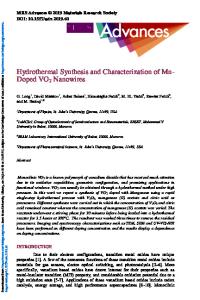Hydrothermal Synthesis and Characterization of ThO 2 , U x Th 1-x O 2 , and UO x
- PDF / 3,882,713 Bytes
- 7 Pages / 612 x 792 pts (letter) Page_size
- 28 Downloads / 319 Views
Hydrothermal Synthesis and Characterization of ThO2, UxTh1-xO2, and UOx Jacob Castilow,1,2, Timothy W Zens1, J. Matthew Mann3, Joseph W. Kolis4, Colin D. McMillen4, James Petrosky1 1
Air Force Institute of Technology, Wright Patterson AFB, OH, United States. Oak Ridge Institute for Science and Education, Oak Ridge, TN, United States. 3 Air Force Research Laboratory, Sensors Directorate, Wright Patterson AFB, OH, United States. 4 Center for Optical Materials Science and Engineering Technologies and Department of Chemistry, Clemson University, Clemson, SC United States. 2
ABSTRACT Hydrothermal synthesis of ThO2, UxTh1-xO2, and UOx at temperatures between 670°C and 700°C has been demonstrated. Synthesis at these temperatures is 50-80°C below prior growth studies and represents a new lower bound of successful growth. ThO2 single crystals of dimensions 6.49mm x 4.89mm x 3.89 mm and weighing 0.633g have been synthesized at average growth rates near 0.125mm/week. Single crystal UxTh1-xO2 crystals with mole fractions up to x≈0.30 have also been grown. The largest alloyed crystal with mole fraction x≈0.23 has dimensions of 2.97mm x 3.23mm x ~3mm and recorded average growth rates near 0.2mm/week. Four structures were solved from X-ray diffraction data and their crystallographic data reported here. Rocking curve analysis determined a dislocation density of 1.2×109 cm-2. INTRODUCTION Solid state materials containing uranium isotopes present a superb neutron detection medium for novel single neutron detectors [1]. The capture and subsequent fission of uranium releases a large amount of energy, >165 MeV, that if converted into an electrical signal would be distinct from any other radiation interaction in the material [2]. This concept has already proven useful in gas filled fission chambers, currently in use in nuclear reactors. However, if in the solid state, such detectors would have a smaller geometry and require less power; thus providing more discrete details about the neutron flux, and depending upon isotopic content, may allow for neutron spectroscopy.[3] This is accomplished by capturing the energy of both fission fragments within the solid state medium and circumventing the need for a gas medium. Further, gas chambers are subject to leaks at high operating temperatures and are limited in efficiency due to conversion material volume [4]. The benefits of single crystals for neutron detection include: use in high neutron fluxes [5], insensitivity to gamma rays[6], and easy discrimination of alpha particles [7]. Further, single crystal UO2 has been shown to be highly resistant to radiation damage [8]. These qualities make singe crystal uranium dioxide compounds an attractive candidate for neutron detection devices. The high melting temperature of refractory oxides like UO2 and ThO2 precludes the use of traditional melt growth techniques like the Czochralski method [9]. While flux growth methods have been employed to synthesize such materials at lower temperatures, the accompanying flux impurities are severely detrimental t
Data Loading...











